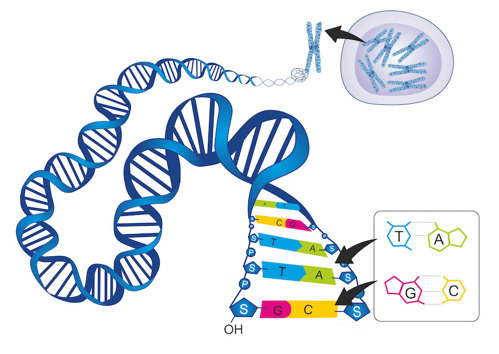
Can you compare human and plant DNA?
January 14, 2005

- Related Topics:
- Comparing species,
- Genomics,
- DNA sequencing,
- Evolution,
- Plant biology
A curious adult from Utah asks:
“How true is the saying “the apple does not fall far from the tree”? Please give a comparison of human and plant DNA. A picture of plant and human DNA sequences would be nice, so that I can see the similarities.”
In some ways, the saying is very true. The building blocks and shape of DNA molecules in humans, plants and every living thing is the same -- we all have the famous A, C, G, and T’s. It’s the order of these letters that makes us different.
Some of these A, C, G, and T’s code for genes, which in turn code for proteins. Proteins are the things in our body that do all of the work. They are involved in activities like digesting food, thinking, and breathing.
Not surprisingly, the proteins that do the same things in plants and animals have similar DNA sequences. However, even when the proteins are very similar, when and where in the body they do their job can be very different.
As you can imagine, the different features of a plant and a human leads to them having many different genes. There are also many similar activities between plants and humans.
Some examples are getting energy from food, making new and fixing DNA, and making new cells by cell division. So it makes sense that the DNA sequences of the genes that work in these sorts of jobs can be very similar, as I’ll show you later on.

DNA Structure
When we think of a banana and a person, it’s easy to assume that their DNA molecules might be different. In fact, the actual structure of the DNA molecule and how it codes for proteins is the same from bacteria to yeast to plants and animals.
The DNA molecules in plants, humans, and all living things are all the same shape – like a twisted ladder, or a double helix. The backbone of the ladder is made up of sugar and phosphate molecules.
Each rung of the ladder is made up of two bases that stick out from the backbone and pair in the middle (a base pair). The letters A, T, G, and C represent the names of these bases. The ladder is twisted, forming the DNA molecule with which we are familiar.
DNA is folded, stored, copied, and used as a blueprint to make proteins in the same way in all living things. So why are living things so different? Some of the differences come from the order of A, T, C, and G’s and the proteins for which they code, the time and place these proteins are made, and the number of chromosomes and genes.

Comparing Genomes
Below is a table with genome size (number of base pairs), number of chromosomes, and number of genes for several species. As you can see, there is almost no connection between the size of the genome and the complexity of a plant or animal.
|
Species |
Number of Chromosomes |
Number of Genes |
Size of Genome (million base pairs) |
|
Human1 |
46 |
~25,000 |
3,300 |
|
Chicken2 |
78 |
~23,000 |
1,000 |
|
Fruit Fly3 |
8 |
~14,000 |
165 |
|
Wall cress4 |
10 |
~25,000 |
125 |
|
Corn5 |
20 |
~59,000 |
2,500 |
|
Rice6 |
24 |
45-56,000 |
441 |
Going back to the question of similarities between plants and humans, I mentioned that plant and animal cells do some of the same things. The genes involved in these functions have similar sequences in plants and animals. One of these functions is called cellular respiration.
Cellular respiration is the process that converts sugar and oxygen to water and carbon dioxide to make energy for the cell (it is why we eat). A key player in cellular respiration is a group of proteins called the Cytochrome C Oxidase complex (COX). This complex is made up of 12 proteins, one of which is called COX6B.


Part of the DNA sequence for the COX6B gene for humans and a type of wall cress plant called Arabidopsis thaliana is shown here. The bases (A, T, C, and G) that are the same in both organisms are in red. As you can see, many of them are the same, but just as many are different.
COX6B has the same job in both plants and humans, but their DNA sequences are different. The parts that are conserved (marked red) are probably important for its function and they have remained the same in the two organisms throughout evolution.
It is amazing that the instructions for almost all living things come from DNA. Functions that are unique to a plant or animal have unique proteins, but proteins that do the same things in many organisms have similar instructions or DNA sequences.

Author: Flo Pauli
When this answer was published in 2005, Flo was a Ph.D. candidate in the Department of Genetics, studying tissue-specific gene expression in c. elegans in Stuart Kim’s laboratory. Flo wrote this answer while participating in the Stanford at The Tech program.
 Skip Navigation
Skip Navigation
